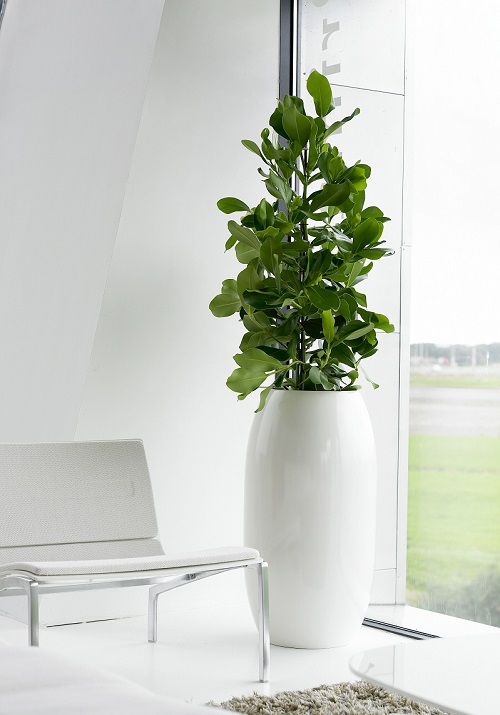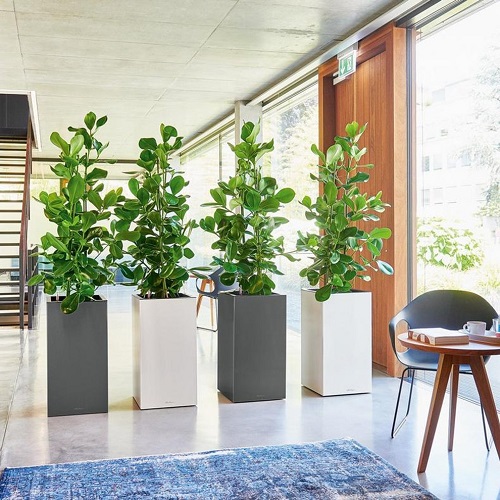Bring home the bold and beautiful Clusia Plant with this informative Autograph Plant Care Guide!
Native to the tropics of America, Clusia is a stunning evergreen shrub that thrives well both as an indoor and outdoor specimen if certain growth conditions are fulfilled. Learn all about growing this fantastic plant indoors with our extensive Autograph Plant Care Guide!
- Botanical Name: Clusia rosea
- Common Names: Autograph Plant, Pitch Apple, Balsam Apple
- Reaches upto 4-6 feet indoors
- Prefers bright indirect sunlight
- Thrives in a temperature range of 60-85 F (15-29 C)
- Toxic to pets
What is Clusia Plant?

Popular as Autograph Plant, Clusia is a tropical tree belonging to the Clusiaceae family. This evergreen shrubby plant features thick, leathery, elliptical leaves that are typically dark green and have a glossy appearance. The aerial roots that grow along its branches provide additional support to the plant, besides adding to its aesthetic appeal.
With a fairly handsome height of about 6 feet indoors, the Clusia Plant can grow upto 25 feet outdoors. As an indoor plant, you may control its growth by regular pruning and planting it in a restrained pot. However, if you want a statement-making specimen to grace your living, the Autograph Plant fits perfectly with its tall stature, hardy nature, and potency in improving indoor air quality.
Check out the Best Bonsai Fruit Trees Here
Ideal Pot Size
The ideal pot size for Growing Clusia Plant Indoors depends on the plant’s root ball and the size you want it to attain. For younger Clusia Plants, a 6-8 inch pot with good drainage is ideal. As the plant matures, you’ll need to repot it into a size larger container every 2-3 years.
A 12-16 inches pot with ample drainage holes is good enough for a mature plant. However, if you want to enjoy the plant in its full glory, you may keep upgrading the pot size every alternate year until the plant reaches your desired height. However, ensure to use plant caddies or moveable planters, as moving a matured clusia plant growing in a large planter might be challenging.
Clusia Propagation

One of the most effective methods of Clusia Propagation is through stem cuttings. Here are the steps to follow:
- Choose a healthy and robust Clusia Plant and select a stem 6-8 inches long stem. Ensure the stem has at least two to three sets of leaves.
- Using a clean, sharp knife or pruning shears, make a clean cut just below a leaf node.
- Remove any lower leaves from the cutting, leaving only a pair at the top.
- Dip the cut end in a rooting hormone to boost the chances of successful propagation.
- Fill a small pot with a well-draining potting mix and plant the clusia cutting.
- Keep the medium moist and place the pot in a spot with bright, indirect sunlight.
Roots will typically form within 4-6 weeks. To check for root growth, gently tug on the cutting. If you feel resistance, roots have likely developed. Once the cutting has developed a healthy root system, hold back on watering and provide it with a favorable growing environment.
Clusia Plant Care

Light
Clusia Plants require a minimum of 4-6 hours of bright, indirect sunlight on a regular basis. However, prolonged exposure to direct, overhead sunlight will scorch its leaves. A west-facing window can be an appropriate place with a few hours of medium, bright sunlight. You may also place it near a south-facing window, shielding the mid-day sun with a sheer curtain.
Do remember that insufficient light can result in leggy growth and diminished foliage. Keep rotating the plant once or twice a week to ensure an even distribution of sunlight.
If you don’t have access to ample natural light, you can supplement with LED grow lights or fluorescent lights. Position the lights about 12-18 inches above the plants and keep them on for around 12-14 hours a day to mimic natural daylight.
Soil
When it comes to soil requirements, Clusia Plants prefer a nutrient-rich, well-draining potting mix with a pH level ranging from 6.0 to 7.0. To hit the perfect balance, mix 60% potting soil, 20% perlite or coarse sand, 10% organic compost, and 10% peat moss.
Coarse sand particles help prevent the soil from becoming compacted and promote root health. Compost also aids in moisture retention, and peat moss maintains a balanced level of moisture in the soil while still allowing excess water to drain effectively.
Watering
When watering, aim to moisten the soil thoroughly. Water until you see water coming out of the drainage holes at the bottom of the pot. This ensures that the water has reached the deeper root zone of the plant.
However, Clusia Plants are prone to root rot, so you must allow the top layer to dry out slightly between waterings. Check the moisture level of the soil by inserting your finger about an inch deep into the soil. If it feels dry at that depth, it’s time to water.
The frequency of watering will depend on the temperature, humidity levels, and the size of the pot. As a general rule of thumb, Clusia Plants need watering about once a week, but ensure to assess the soil moisture level and adjust accordingly. During winter or cooler months, reduce the frequency to avoid plant stress.
Temperature and Humidity
Clusia Plants thrive in temperatures ranging from 60-85 F (15-29 C). Although they can tolerate slightly cooler temperatures, the plant must not be exposed to degrees below 50 F or 10 C. To ensure optimal growth, maintain a consistent temperature, keeping it away from drafty areas or ac vents.
In terms of humidity, Clusia prefers moderate to high humidity levels, ideally around 50-70%. Misting the leaves occasionally, grouping them with humidity-loving plants, or using a humidifier can help create a humid environment that replicates their natural habitat.
Fertilizer
Use a balanced, slow-release fertilizer with an NPK ratio of 10-10-10 or 14-14-14 every 3-4 weeks during the spring and summer months. Do remember that over-fertilizing can harm the plant more than under-fertilizing.
Dilute the fertilizer to 1/4th its strength and reduce the frequency of fertilization to once every 6-8 weeks during the colder months.
Pruning
The best time to prune your Clusia Plant is during the late winter or early spring before the new growing season begins. This will allow the plant to focus its energy on producing new growth in the pruned areas. Look for any yellowing or browning leaves, weak growth, or branches that are growing out of shape to snip them off.
Always use clean and sharp pruning shears to avoid the spread of diseases. If you want to control the growth of your Clusia, simply trim back the branches to create your desired shape. Be careful not to remove more than a third of the plant at one time.
Major Troubleshooting Tips

- Wilted or Yellow Leaves: Wilted or yellow leaves in Clusia plants can indicate overwatering, underwatering, or root problems. Check the moisture level in the soil and adjust watering accordingly, and always allow the top inch of soil to dry out before watering again.
- Curling or Crispy Leaves: This may be caused by inadequate humidity, insufficient watering, or exposure to extreme temperatures. Increase humidity around the plant by misting the leaves or placing a tray of water nearby. Adjust the watering schedule to ensure the plant is receiving adequate moisture without overwatering.
- Leggy or Sparse Growth: Leggy or sparse growth in Clusia plants can result from insufficient light or overcrowding. Provide the plant with brighter, indirect light and move it closer to a window or supplement with artificial grow lights if necessary.
- Pests: Clusia plants can be susceptible to pests such as mealybugs, scale insects, and spider mites. Identify the specific pest and apply the appropriate treatment, such as using insecticidal soap or neem oil. Also, regularly inspect the plant for signs of pests and isolate any infested plants to prevent spreading.
Where to Buy Clusia?

Visit your local nurseries and garden centers to find a variety of Clusia Plants. These establishments often offer expert advice and a wide selection of healthy plants to choose from. Speak with the staff to ensure you pick the right variety for your needs.
Online platforms like Etsy, eBay, and plant-specific websites often feature individual sellers offering Autograph Plant, which can be a good option. You can also check the Facebook Marketplace for local sellers offering Clusia for Sale. This option can provide opportunities to connect with local gardeners and find unique varieties.






